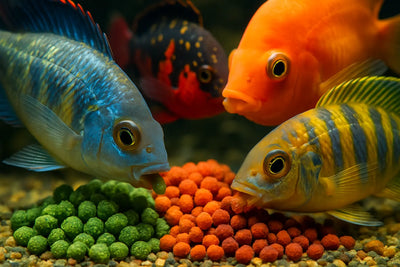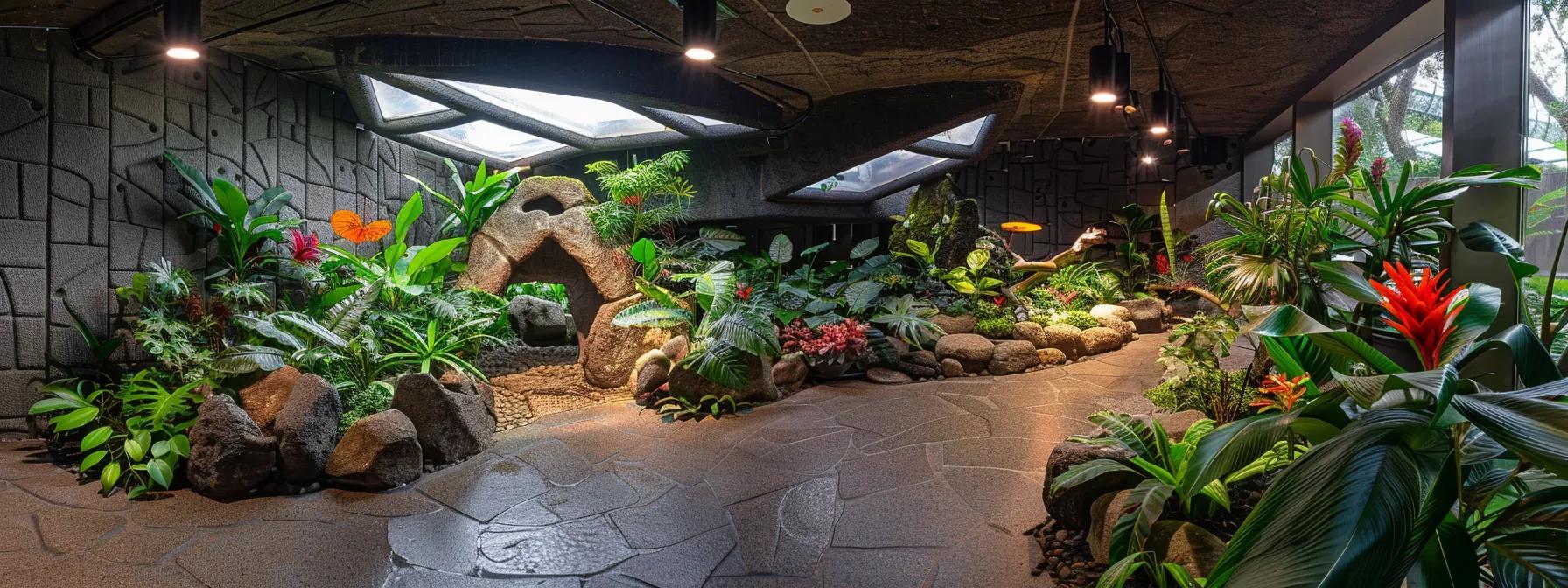
Reptile Cage Decoration Ideas for Stunning Enclosures
In today’s pet supply market, reptile enthusiasts seek ways to create natural, engaging, and attractive habitats for their scaly companions. Reptile cage decoration involves more than aesthetics—it covers important aspects of animal husbandry such as behavior, substrate comfort, lighting, humidity, and replicating the reptile’s natural environment. Species like leopard geckos, bearded dragons, ball pythons, and crested geckos require specific conditions to thrive, so customizing their enclosures is essential for both health and behavioral enrichment. This article explains the essential decorative elements for reptile cages, customization methods for different species, expert maintenance tips, and cost-effective upgrade ideas. Detailed lists and tables compare various decorative components, enabling pet store customers and hobbyists to make informed decisions while enhancing the overall well-being of their reptilian pets.
Transitioning into the core topics, the article is structured around several key questions covering decorative elements, species-specific customization, different cage types, budget-friendly designs, expert maintenance tips, naturalistic and modern design strategies, and common questions about reptile cage decoration.
What Are the Essential Decorative Elements for Reptile Cages?
Effective cage decoration delivers both functionality and visual appeal. Key elements include substrates, plants, hides, climbing structures, lighting, water features, and backgrounds. Every component is selected to generate an environment that satisfies reptile instincts while ensuring optimal health.
Which Substrates Are Best for Different Reptile Species?
Substrates are not only aesthetic but also influence reptile behavior and health. They line the bottom of the terrarium and provide the first layer of interaction with the enclosure.
Popular substrate choices include: 1. Reptile Carpet – Soft, non-abrasive, and easy to clean. 2. Coco Fiber – Retains moisture and creates a natural look. 3. Organic Soil Mix – Ideal for burrowing species; encourages natural digging. 4. Cork Bark Mulch – Offers varied textures for climbing and hiding. 5. Paper Towels – Best for quarantine settings due to easy sterilization. 6. Sand-based Substrate – Used for desert species; requires monitoring to prevent impaction. 7. Peat Moss Mix – Helps maintain humidity and gives a lush appearance.
Each substrate influences moisture retention, hygiene, and overall functionality. The choice should match the reptile’s native habitat; for example, crested geckos benefit from substrates that allow vertical climbing and provide varied textures for grip.
How to Choose Safe and Attractive Plants for Reptile Enclosures?
Plants enhance a vivarium by offering visual appeal, oxygenation, and humidity regulation while creating a mini-ecosystem. Key guidelines for plant selection include:
- Non-toxicity: Plants must be safe if ingested.
- Humidity Compatibility: Choose species that thrive in the enclosure’s moisture.
- Low Maintenance: Opt for hardy plants that resist decay.
- Naturalistic Appearance: Select plants that mimic the reptile’s native habitat.
- Secure Planting Options: Use pots or mountings to keep plants secure.
- Size Consideration: Avoid plants that are too tall or expansive.
- Artificial Alternatives: Use durable, non-toxic faux plants if needed.
By integrating live or artificial plants, owners can promote natural behaviors such as hiding, basking, and foraging.
What Types of Hides and Climbing Structures Enhance Reptile Well-Being?
Reptiles need safe retreats to escape predators and regulate their temperatures. Hides and climbing structures support these natural behaviors.
Examples include: 1. Cave-Like Hides: Provide secluded spots for resting and thermoregulation. 2. Log and Rock Arrangements: Mimic natural shelters while offering visual appeal. 3. PVC or Wooden Platforms: Allow vertical exploration. 4. Artificial Vines: Offer additional climbing opportunities. 5. Hammocks: Provide unique resting spots. 6. Hides with Heating Elements: Offer both security and warmth. 7. Stacked Driftwood: Enhances texture and natural appearance.
Mixing multiple types of hides and climbing structures gives reptiles various enrichment opportunities, thus reducing stress and enhancing cognitive and physical activity.
How Does Lighting Impact Reptile Cage Decoration and Health?
Lighting is critical for thermoregulation, metabolism, and behavioral cycles. A balanced setup includes basking bulbs, UVB lights, and ambient fixtures.
Key lighting considerations: - Natural Day-Night Cycle: Use timers to mimic natural rhythms. - UVB Exposure: Ensures vitamin D3 synthesis for calcium metabolism. - Strategic Positioning: Lighting should enhance decor and minimize glare. - Basking Areas: Must have high-intensity bulbs for proper thermoregulation. - Dimmable Features: Adjustable lighting can simulate sunrise and sunset. - Safety and Efficiency: Choose energy-efficient fixtures designed for reptile enclosures. - Heat Management: Assess the heat output to avoid overheating spots.
Integrating lighting enhances both functionality and visual appeal, ensuring reptiles receive warmth while highlighting decorative features.
What Are the Benefits of Adding Water Features and Backgrounds?
Water features and backgrounds transform a basic tank into an immersive habitat. They provide functional benefits and improve the vivarium’s aesthetics.
Benefits include: - Humidity Enhancement: Critical for species that need moist conditions. - Naturalistic Backdrops: Visually connect the enclosure to the reptile’s origins. - Temperature Modulation: Contribute to a balanced microclimate. - Enrichment Opportunities: Reflective surfaces and gentle water sounds stimulate natural behavior. - Safe Drinking Sources: Provide additional areas for hydration and cleaning. - Stress Reduction: Familiar environments lower stress levels. - Unified Landscape: Bring together different decorative components into a cohesive display.
By using water elements and backgrounds, owners can create a striking yet functional enclosure.
How Do You Customize Cage Decoration for Specific Reptile Species?
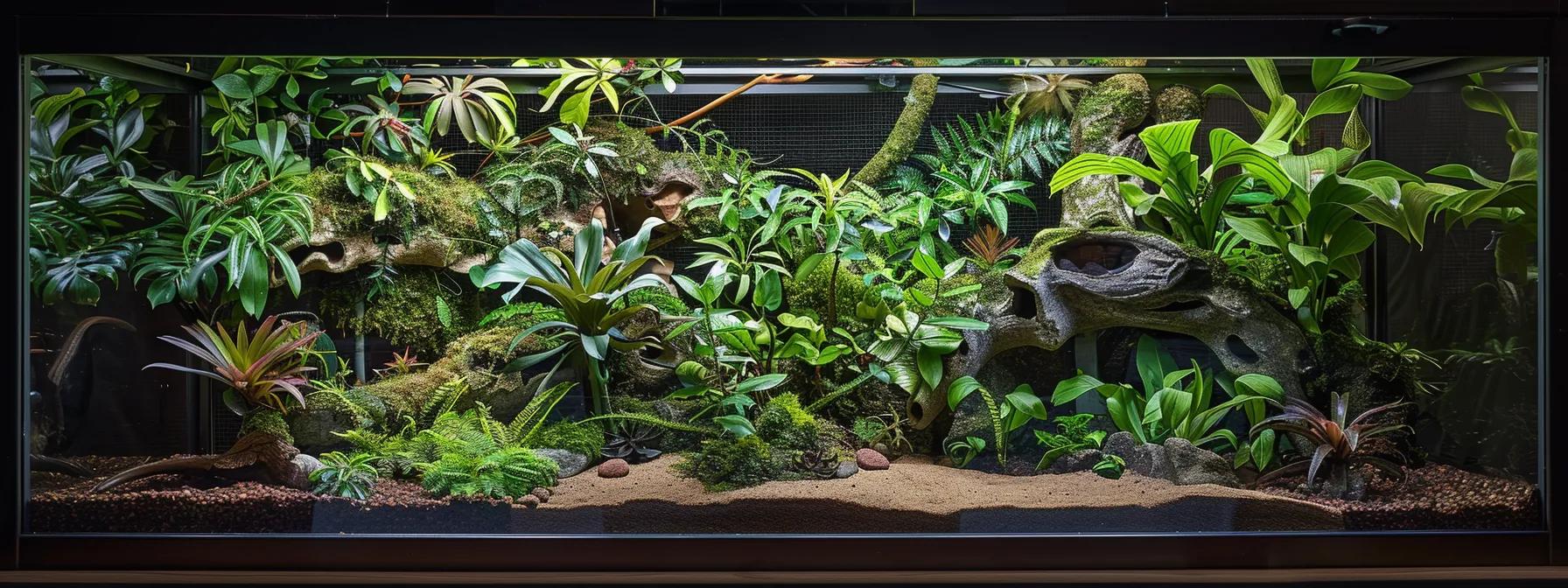
Customizing decoration based on species is vital due to the unique environmental needs of different reptiles. Tailoring substrates, plants, hides, and lighting can significantly improve both physical health and psychological well-being.
What Are Leopard Gecko Cage Decoration Ideas for a Naturalistic Habitat?
Leopard geckos thrive in arid, rocky environments. Their enclosures should mimic these conditions.
Key ideas for leopard gecko decor: 1. Reptile Carpet Base: Provides a safe, easy-to-clean foundation. 2. Rock Hides: Mimic natural crevices for shelter. 3. Cork Bark Logs: Offer texture and climbing opportunities. 4. Artificial Desert Plants: Create a natural look without extensive maintenance. 5. Subdued Lighting Fixtures: Provide secure areas for basking. 6. Moss or Lichen Accents: Add natural detail without excess moisture. 7. Custom Background Murals: Simulate rocky outcrops or desert horizons.
This design supports concealment and regulated temperatures, promoting natural foraging and reducing stress.
How to Decorate a Bearded Dragon Enclosure for Optimal Comfort and Style?
Bearded dragons require enclosures that replicate arid, rocky landscapes with both basking areas and secure hides.
Decorative tips include: 1. Naturalistic Sand-Soil Substrate: Combines ease of cleaning with a realistic appearance. 2. Multiple Rock Hides: Create areas of sun and shade. 3. Branch and Log Arrangements: Encourage climbing and exploration. 4. Customized Terrain Sculptures: Simulate rocky outcrops for visual appeal. 5. Integrated Basking Platforms: Provide specific zones for warming. 6. Artificial Medicinal Plants: Offer additional shade and aesthetic value. 7. Background Scenery Panels: Reinforce the natural habitat theme.
This balanced layout fuses functionality with style, ensuring proper thermoregulation and enriching the dragon’s active lifestyle.
What Are Ideal Ball Python Cage Decoration Tips for Security and Aesthetics?
Ball pythons favor enclosures that offer security in a subdued environment.
Key decorative tips: 1. Secure Hide Boxes: Reduce stress by providing safe retreats. 2. Non-Abrasive Substrate Options: Use reptile carpet or similar materials to prevent injury. 3. Layered Background Textures: Employ backgrounds that mimic rock or moss. 4. Minimalist Plant Elements: Use non-toxic, durable artificial plants for visual cues. 5. Subdued Lighting: Protect the snake from harsh glare. 6. Customizable Climbing Branches: Offer occasional exploratory stimuli. 7. Integrated Heating Pads: Ensure consistent warmth without altering decor.
The combination of secure hides and minimalistic decoration helps create an environment that supports the snake’s natural hiding instincts and reduces stress.
How to Create a Crested Gecko Cage That Balances Climbing and Hiding Needs?
Crested geckos need enclosures that allow vertical exploration along with secure hiding places.
Effective strategies include: 1. Vertical Branch Structures: Promote climbing and exercise. 2. Expansive Backgrounds: Replicate forest settings with layered textures. 3. Multiple Hide Spots: Provide both ground-level and elevated retreats. 4. Safe Artificial Plants: Offer natural cover and help reduce noise. 5. Non-Toxic Substrates: Support moisture without risk of ingestion. 6. Integrated Humidity Controls: Use misting systems built into the decor. 7. Customizable Climbing Ledges: Vary textures and elevations to stimulate exploration.
This balanced design encourages natural behavior while reducing stress and supporting both physical and mental stimulation.
Why Is Species-Specific Customization Important for Reptile Health?
Different reptiles thrive under varying environmental conditions. Customizing decoration to match specific needs improves temperature control, humidity regulation, and overall security.
Benefits include: - Improved thermoregulation and metabolic balance. - Lower stress levels and better immune function. - Promotion of natural feeding and activity behaviors. - Enhanced aesthetic appeal and easier observation. - Greater owner satisfaction with successful pet keeping. - Better growth rates and potential for breeding.
Tailoring decor not only ensures health but also enriches a reptile’s environment with a spectrum of natural stimuli.
What Are the Best Cage Types and How Do They Influence Decoration Choices?
The cage type influences decoration strategy by affecting lighting diffusion, humidity control, and overall aesthetics. Glass terrariums, wooden enclosures, and PVC cages each offer distinct benefits and challenges.
How to Decorate Glass Terrariums for Maximum Visual Appeal and Function?
Glass terrariums are excellent for showcasing intricate decor but require thoughtful planning to manage light reflection.
Key strategies include: 1. Gradient Background Panels: Add depth by simulating natural horizons. 2. Layered, Textured Substrates: Create dynamic, visually appealing floors. 3. Artificial Vines and Plants: Provide greenery that is easy to maintain. 4. Elevated Hides: Balance open space with secure areas. 5. Integrated Misting Systems: Offer subtle humidity control. 6. Reflective Accents: Use mirrors or glossy surfaces to amplify light. 7. Sturdy Climbing Structures: Ensure safe exploration zones.
This approach creates a cohesive environment that is both functional and eye-catching.
What Are Effective Decoration Ideas for Wooden Reptile Enclosures?
Wooden cages evoke a natural atmosphere and offer excellent insulation. Decoration should complement the wood’s texture.
Ideas include: 1. Carved Wooden Hide Boxes: Blend seamlessly with the enclosure. 2. Integrated Rock and Bark Elements: Mimic natural hideaways. 3. Natural Fiber Substrates: Use coconut fiber or organic soil mixes. 4. Live Plant Integrations: Enhance the natural aesthetic. 5. Custom Painted Backgrounds: Reflect forest or desert scenes. 6. Eco-Friendly Misting Systems: Work with the wood’s absorbent nature. 7. Unique Climbing Branches: Maintain a rustic, natural appearance.
These additions highlight the warmth and organic feel of wooden enclosures.
How to Style PVC Cages With Safe and Durable Decorative Elements?
PVC cages are durable and easy to clean but can appear industrial. Decorations must compensate with texture and color.
Effective strategies include: 1. Removable Vinyl Backgrounds: Easily update the scene. 2. Artificial Rock Formations: Lightweight and safe for climbing. 3. Modular Climbing Structures: Enable flexible layouts. 4. Non-Toxic Artificial Plants: Provide consistent aesthetics. 5. Custom Hide Boxes: Fit smooth PVC surfaces securely. 6. Integrated Misting Devices: Enhance humidity without compromising structure. 7. Colorful Accents: Use safe decals to add visual interest.
This plan achieves a natural look while preserving PVC’s practical strength.
How Does Cage Material Affect Lighting and Humidity Setup?
Cage materials influence how light and moisture are managed. For example, glass and PVC retain humidity while wood absorbs and slowly releases it.
Key factors include: - Light Reflection: Glass may require diffusers to reduce glare. - Heat and Insulation: Wood supports a warm, stable environment. - Moisture Control: Non-porous surfaces need external systems for humidity. - Accessory Integration: Surface texture affects how decor is attached. - Maintenance: Some materials may require more frequent cleaning. - Overall Safety: Avoid hotspots by choosing appropriate materials.
Understanding these factors helps optimize both lighting and humidity in the enclosure.
How Can You Design Stunning Reptile Cages on a Budget?
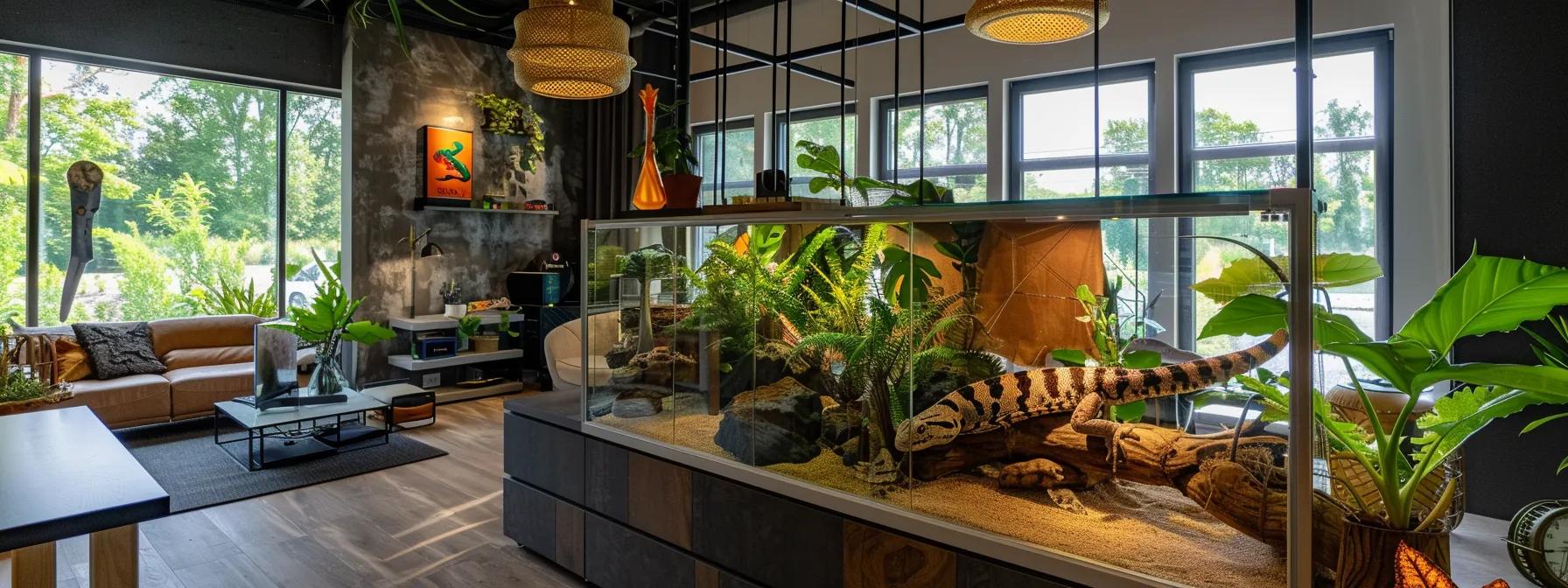
Creating an attractive, functional reptile cage on a budget is possible with creativity and resourcefulness. It involves smart use of recycled materials, DIY projects, and repurposing everyday items.
What Are Easy DIY Reptile Cage Decoration Projects?
DIY projects allow for customization without high costs. They use basic tools and recycled or natural materials to create unique accessories.
Examples of DIY projects include: 1. Cork Bark Hide Boxes: Easily crafted from leftover cork. 2. PVC Pipe Climbing Structures: Cut and assembled for secure routes. 3. Hand-Painted Background Panels: Use non-toxic paints for a natural scene. 4. Recycled Plastic Planters: Convert small containers into planters. 5. DIY Misting Systems: Assemble low-cost setups for humidity. 6. Upcycled Driftwood Branches: Clean and prepare for safe use. 7. Fabric Accent Pieces: Repurpose old fabrics for added color and texture.
These projects allow owners to tailor their cages while maintaining affordability and sustainability.
How to Use Natural and Recycled Materials for Cage Decoration?
Using natural and recycled materials is both cost-effective and eco-friendly. They reduce expenses while promoting sustainability.
A breakdown of useful materials: - Reclaimed Wood: Great for hides or perches. - Recycled Plastic: Versatile for decorative planters. - Natural Stones and Rocks: Add texture and mimic natural conditions. - Leftover Cork Bark: Ideal for rustic hide boxes. - Organic Soil or Coco Fiber: Provides a natural substrate. - Old Fabric Scraps: Can add color after proper cleaning. - Recycled Glass Pieces: Smooth accents for decoration.
This approach creates a cohesive, natural look while respecting a budget.
Which Affordable Decorative Elements Provide Enrichment and Style?
Affordable decor must combine function with visual appeal.
Consider these elements: 1. Plastic or Silicone Plants: Inexpensive and non-toxic. 2. Recycled Cork Hides: Simple to fabricate and effective. 3. Basic Reptile Carpets: Economical base substrates. 4. DIY PVC Climbing Branches: Affordable and fun to assemble. 5. Printed Background Panels: Add depth without high cost. 6. Low-Cost Heating Pads: Essential for thermoregulation. 7. Affordable Misting Systems: DIY options for efficient humidity control.
These items enhance both enrichment and style while remaining budget-friendly.
How to Maintain a Beautiful Cage Without High Costs?
Maintenance involves regular cleaning, updates, and creative reuse. Preventive care prolongs the life of each decorative element.
Key tips include: 1. Regular Cleaning Schedules: Establish daily and weekly routines. 2. Periodic Deep-Cleaning: Replace substrates and decor as needed. 3. DIY Upcycling Projects: Repurpose older elements into new designs. 4. Routine Equipment Checks: Monitor lighting, heating, and misting systems. 5. Documenting Changes: Keep logs of maintenance and replacements. 6. Simple Repairs: Address minor issues with affordable DIY solutions. 7. Budget Inventory Management: Purchase replacements in bulk when possible.
Consistent maintenance ensures a visually stunning and functional habitat without overwhelming costs.
What Expert Tips Improve Reptile Cage Decoration and Habitat Maintenance?
Experts emphasize that balanced decor and regular upkeep are key to a safe, stimulating habitat. Routine maintenance, proper lighting, and periodic decor rotation keep the enclosure functional and visually appealing.
How to Maintain Substrate and Decorative Elements for Hygiene and Safety?
Maintaining hygiene prevents bacteria and mold buildup.
A recommended routine: 1. Weekly Spot Cleaning: Remove waste and shed skin promptly. 2. Monthly Substrate Replacement: Replace or disinfect substrates regularly. 3. Periodic Deep Cleaning: Use reptile-safe cleaners for decor. 4. Regular Disinfection: Sanitize hides and accessories with diluted disinfectants. 5. Temperature and Humidity Calibration: Adjust equipment as needed. 6. Visual Inspections: Check decor for wear or mold. 7. Scheduled Professional Check-ups: Consult experts periodically.
Following these protocols keeps the enclosure safe and healthy.
What Are Best Practices for Lighting and Temperature Control in Decorated Cages?
Balanced lighting and temperature are vital.
Key practices include: 1. Timed Light Cycles: Use programmable timers. 2. Strategic Bulb Placement: Ensure even distribution of light. 3. Regular Bulb Replacement: Follow manufacturer recommendations. 4. Programmable Thermostats: Maintain consistent temperatures. 5. Use of Diffusers: Prevent harsh lighting. 6. Balancing Warm and Cool Zones: Create distinct temperature areas. 7. Dimmer Controls: Simulate natural sunrise and sunset.
These steps help maintain an optimal environment for reptile health.
How to Rotate and Refresh Cage Decorations to Prevent Boredom?
Changing decor periodically keeps the habitat stimulating and encourages exploration.
Effective strategies: 1. Seasonal Rearrangements: Adjust decor with the seasons. 2. Swapping Decorative Items: Change plants and hides periodically. 3. Introducing New DIY Items: Add freshly made accessories. 4. Changing Background Panels: Create a new ambiance. 5. Altering Plant Placement: Revitalize the enclosure’s look. 6. Simple Upgrades: Use affordable materials for small changes. 7. Observing Behavior: Adjust based on reptile activity. 8. Documenting Changes: Keep a log to track improvements.
Regular rotation keeps the environment engaging and reduces stress.
When Should You Consult Professionals for Custom Cage Design?
Consult professionals when specialized changes or advanced technical setups are required.
Look for signs such as: 1. Persistent Temperature Fluctuations: Indicating inadequate heating or cooling. 2. Recurring Moisture or Mold Issues: Suggesting design flaws. 3. Behavioral Changes: Increased stress or lethargy. 4. Structural Damage: Unsafe decor needing repair. 5. Inadequate Lighting Performance: Failing to meet UVB or basking needs. 6. Unresolved Design Limitations: When DIY efforts fall short. 7. Advanced Customization Needs: For major upgrades or species-specific challenges.
Professional advice ensures the habitat meets all safety and health standards.
What Are the Most Common Questions About Reptile Cage Decoration?
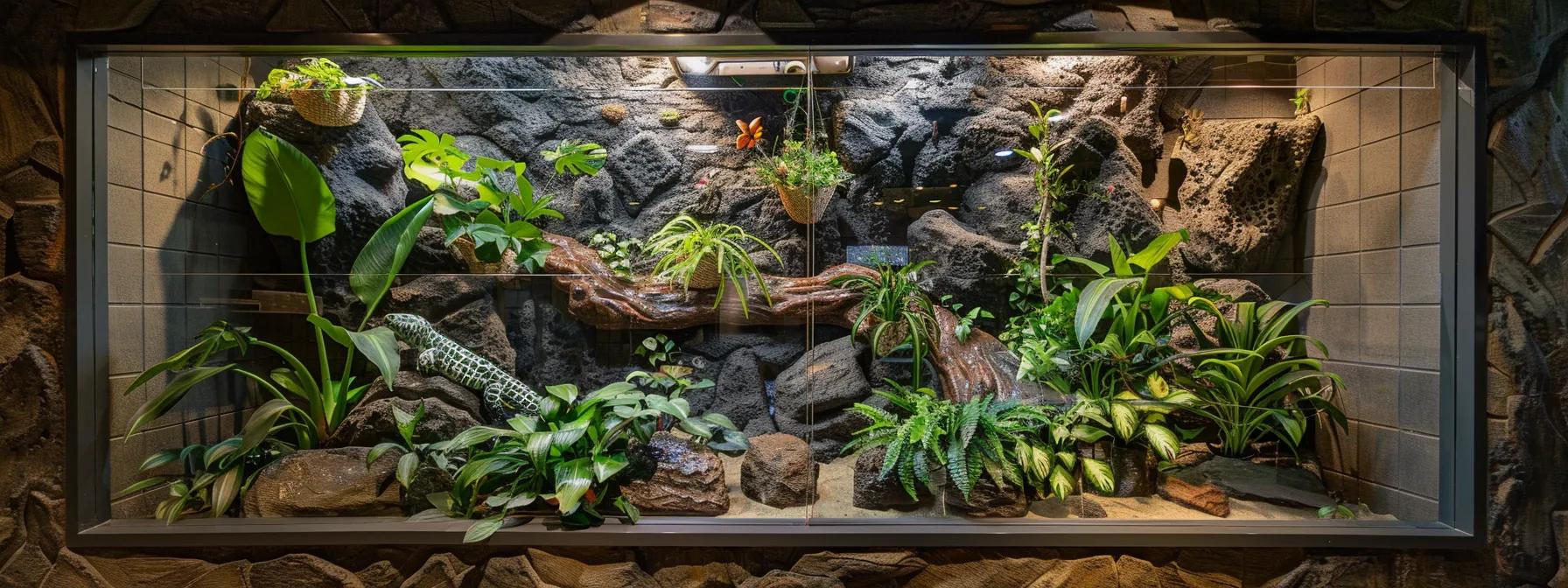
Many reptile owners have common questions about cage decoration. Addressing these helps demystify the process and supports proper animal husbandry.
What Substrates Are Safe for My Reptile Species?
Safety is paramount. Species that burrow may benefit from organic soil with coconut fiber, while leopard geckos are best on reptile carpet or paper towels to avoid impaction. Always use substrates free from pesticides and contaminants, and maintain a regular cleaning schedule.
How Do I Choose the Right Size and Type of Hides?
Hides should be slightly larger than the reptile to ensure full entry without exposure. Choices vary from rock crevices to wooden boxes; select based on natural preferences and ensure multiple options in different temperature zones.
Which Plants Are Non-Toxic and Suitable for Reptile Enclosures?
Non-toxic plants like pothos, spider plants, and certain ferns are popular due to their aesthetic and functional benefits. Always verify toxicity and ensure that live plants receive appropriate lighting and humidity.
How Can I Ensure Proper Lighting for Both Decoration and Health?
Combine basking bulbs and UVB lights on a timer to mimic natural cycles. Position fixtures to highlight decor without creating harsh shadows, and replace bulbs regularly to maintain proper UVB output.
What Are Essential Items Every Reptile Cage Should Have?
Every cage should include secure hides, a proper substrate, safe heating elements, and adequate lighting. Additional essentials may include water features for humidity control, climbing structures for vertical space, and non-toxic decorative plants.
Frequently Asked Questions
Q: How often should I change the substrate in my reptile cage? A: Maintenance frequency depends on the species and substrate type. Reptile carpet and paper towels in quarantine settings may be changed weekly, while natural soil mixes often require monthly replacement. Adhering to a regular cleaning schedule is essential to prevent bacterial growth.
Q: Can I mix live plants with artificial ones in my reptile enclosure? A: Yes, combining live and artificial plants creates a dynamic habitat. Live plants improve oxygenation and humidity control, while artificial ones offer consistent aesthetics. Ensure all live plants are non-toxic and secure.
Q: What type of lighting fixture is best for UVB exposure in reptile cages? A: Fluorescent UVB bulbs are most commonly recommended because they provide the necessary UVB for vitamin D3 synthesis. Mercury vapor bulbs, which combine heat and UVB, can be used with careful positioning to avoid overheating.
Q: How can I tell if my reptile’s enclosure is properly humidified? A: Use a reliable digital hygrometer inside the enclosure. For example, crested geckos typically need 60–80% humidity, while desert species may require 30–50%. Behavioral cues, such as lethargy or overactivity, can signal humidity issues.
Q: Are there any risks associated with DIY decoration projects? A: DIY projects are safe when using non-toxic, pet-safe materials. All materials must be thoroughly cleaned and secured to prevent hazards such as falling decor or choking risks. Always adhere to reptile care standards regarding UVB output and heat management.
Final Thoughts
The world of reptile cage decoration offers endless creative opportunities to enhance both the look and functionality of your vivarium. With the right balance of substrates, plants, hides, lighting, and DIY elements, reptiles can thrive in an environment that closely mimics their natural habitat. Thoughtful, species-specific customization reduces stress and promotes natural behaviors, while expert tips and affordable solutions ensure that the enclosure remains both beautiful and healthy.
| Element | Function | Benefit | Example/Value |
|---|---|---|---|
| Reptile Carpet | Base substrate | Ease of cleaning, safety | Ideal for leopard geckos |
| Organic Soil Mix | Natural substrate | Supports burrowing behavior | Suitable for crested geckos |
| Artificial Plants | Aesthetic boost | Provides cover and oxygenation | Non-toxic varieties |
| Cork Bark Hides | Security | Reduces stress | Customizable shapes |
| PVC Climbing Structures | Vertical enrichment | Promotes physical activity | Modular and durable |
| UVB Lighting | Vitamin D support | Critical for calcium metabolism | 5-10% UVB output |
| Water Misting Systems | Humidity control | Prevents dehydration | Digital control available |
Before implementing any design, assess your reptile species’ specific needs and choose decorative elements that provide both functional and aesthetic benefits.
| Cage Type | Material | Aesthetic Appeal | Lighting Impact | Maintenance | Cost | Durability |
|---|---|---|---|---|---|---|
| Glass Terrarium | Glass | High clarity, modern | Diffusive; may require diffusers | Moderate; careful cleaning | Moderate | High |
| Wooden Enclosure | Wood | Natural, warm | Soft diffusion | Requires occasional sealing | Variable | Mod–High |
| PVC Cage | PVC | Industrial, minimalistic | Opaque; may need extra lighting | Easy to clean | Low | Very High |
| Mesh Enclosure | Metal/Plastic | Classic and open | Minimal light control | High maintenance | Low–Moderate | High |
| Acrylic Cage | Acrylic | Sleek and versatile | Similar to glass; less glare | Comparable to glass | Moderate | High |
| Naturalistic Vivarium | Mixed | Most natural look | Dependent on integration | Requires routine care | Mod–High | Moderate |
| Custom Build | Combo | Tailored to species | Custom-designed | Variable | Variable | Variable |
Before finalizing, consider both the visual impact and technical requirements to ensure every component works synergistically for optimal reptile health.


